ChatBot Best Practices
Essential tips that will help you design a successful chatbot for your business.
If you're reading this guide, you're probably about to implement a chatbot into your business. You're wondering which chatbot platform is the best and how it can help you. Well, this guide provides all the golden rules for implementing a chatbot. It points out the most common chatbot mistakes and shows how to avoid them. It can help you create an effective chatbot strategy and make the most out of chatbots for your online business.

1. List all your problems first
You’ve learned a lot about chatbots and can’t wait to start building your own.
Before you do, though, let’s take a step back and think about your business’s problems that you want to solve with a chatbot. You can open a Miro board and enter all of your issues by topic. You can rank them to see which of them are the most pressing. This will help you to map out your problems and determine which of them are the most important for you to solve.


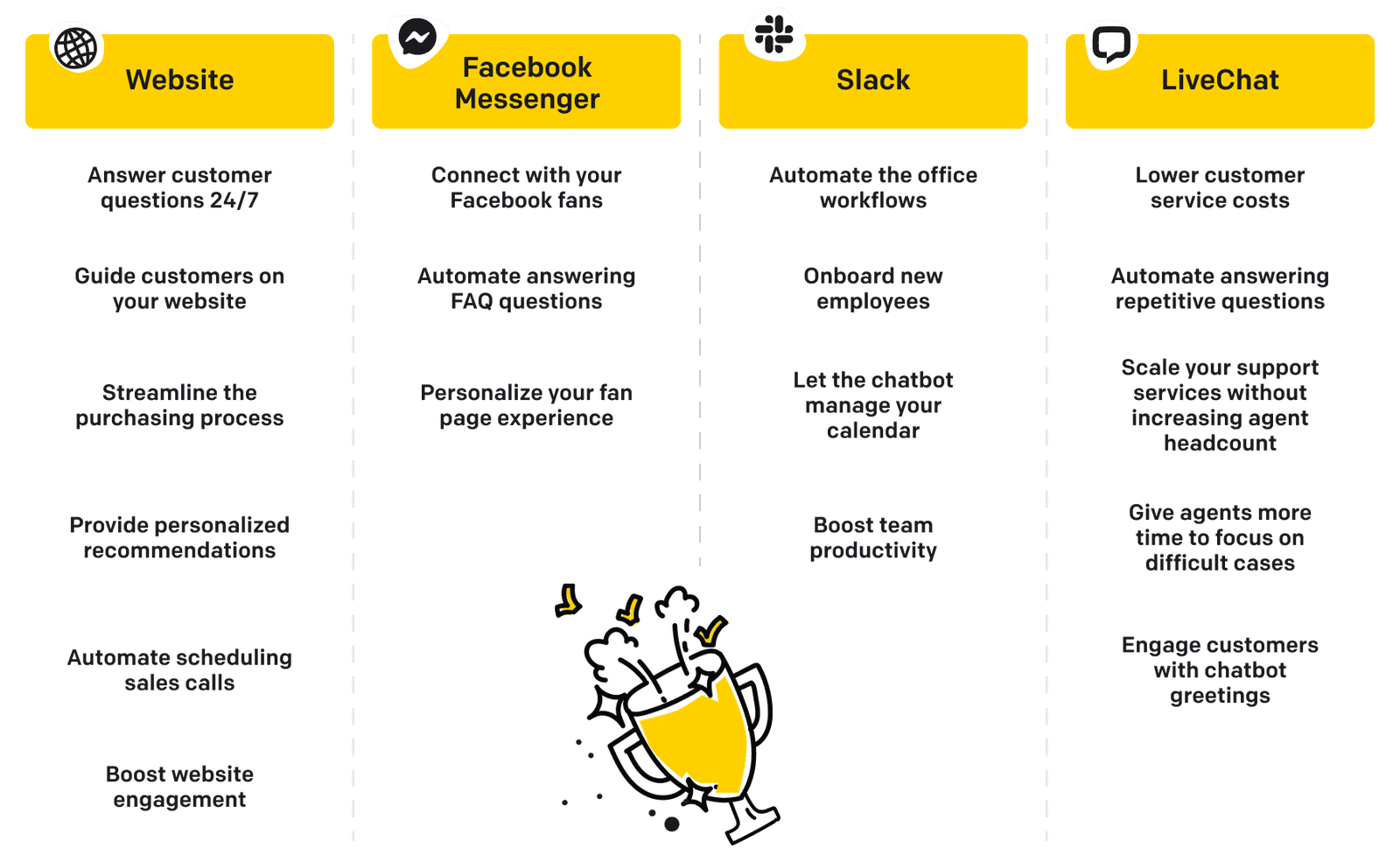

2. Choose your communication channels
Every framework for a chatbot comes with a different package and integrates with different communication channels.
That's why, before choosing your solution, you must first decide where you want to launch your chatbot. If you’re thinking about using a chatbot on Facebook Messenger, you can choose a solution dedicated to Facebook marketing. If you want to automate communication across many channels, it’s better to consider a multi-platform chatbot framework. Using it, you can add a chatbot to multiple communication channels without coding and manage all your bot stories from one place.
3. Select the right chatbot solution
You've already listed your problems and know where and when they occur. Now, it’s time to pick a tool that will make a difference.
The market is full of various chatbot platforms that can help you to automate customer communication, boost sales, and collect customer surveys. What’s the best way to verify which of them will suit you best? See for yourself. Sign up for free trials and ask for product demos. Take the time to test different solutions to find out what they have to offer.
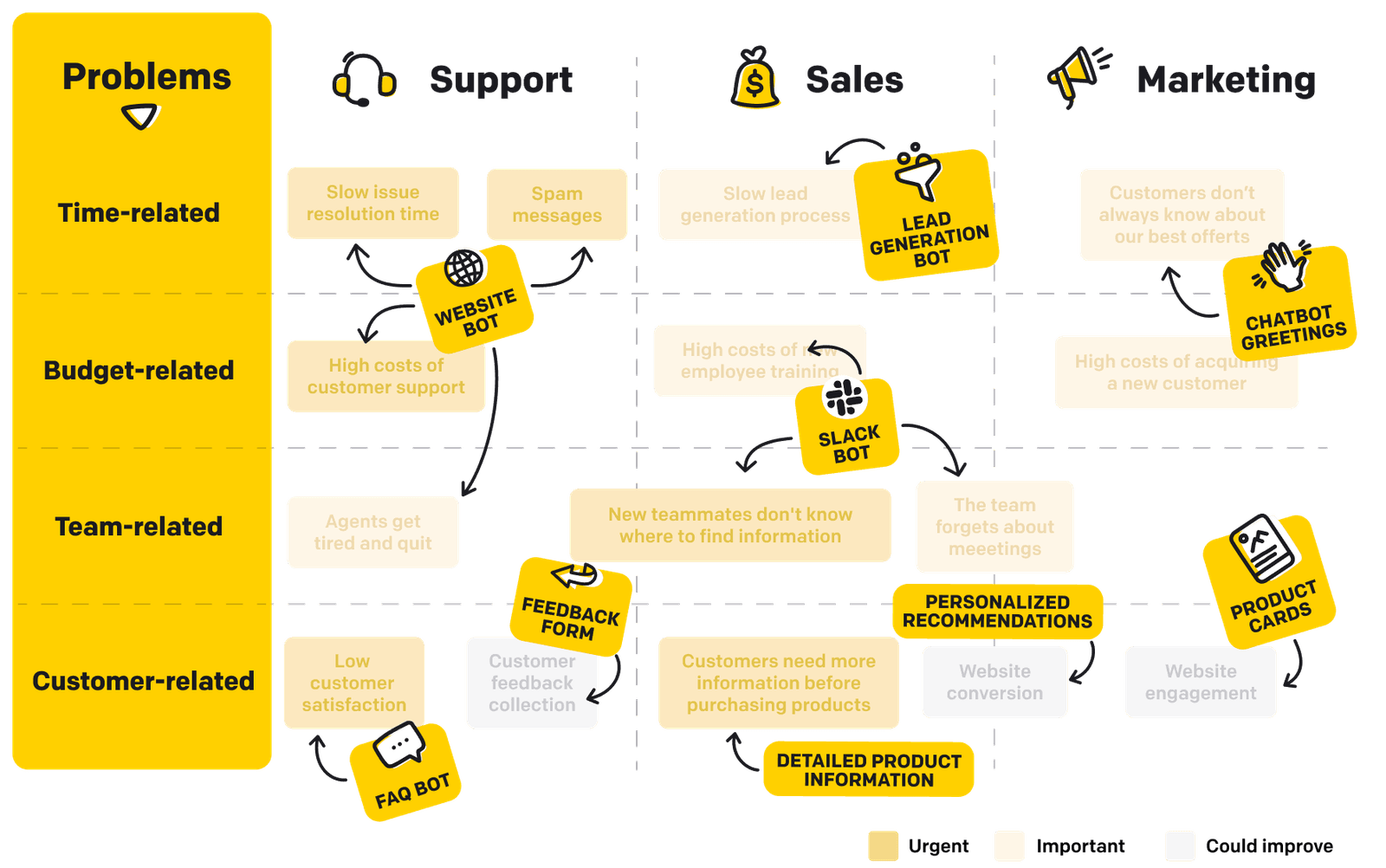

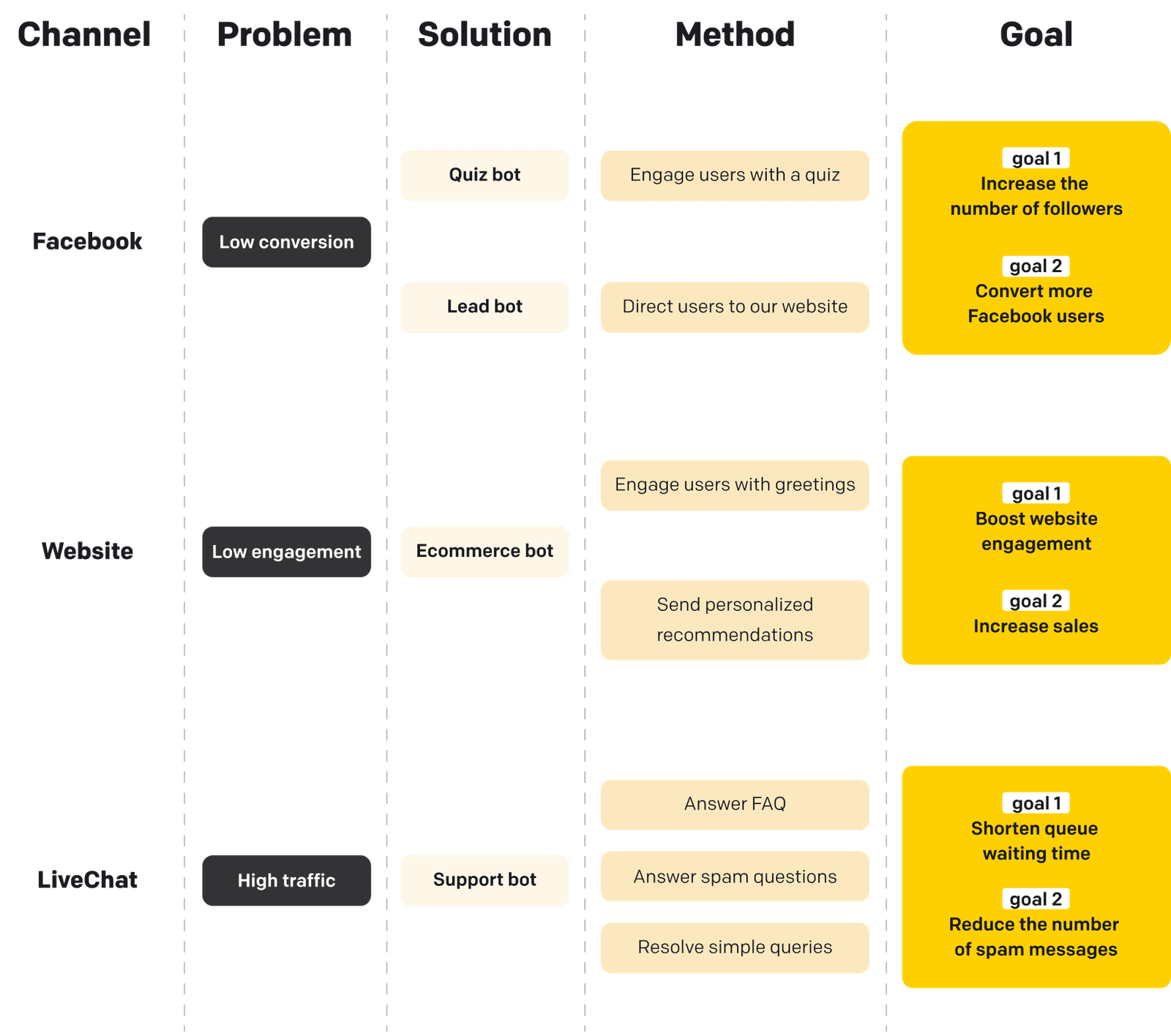
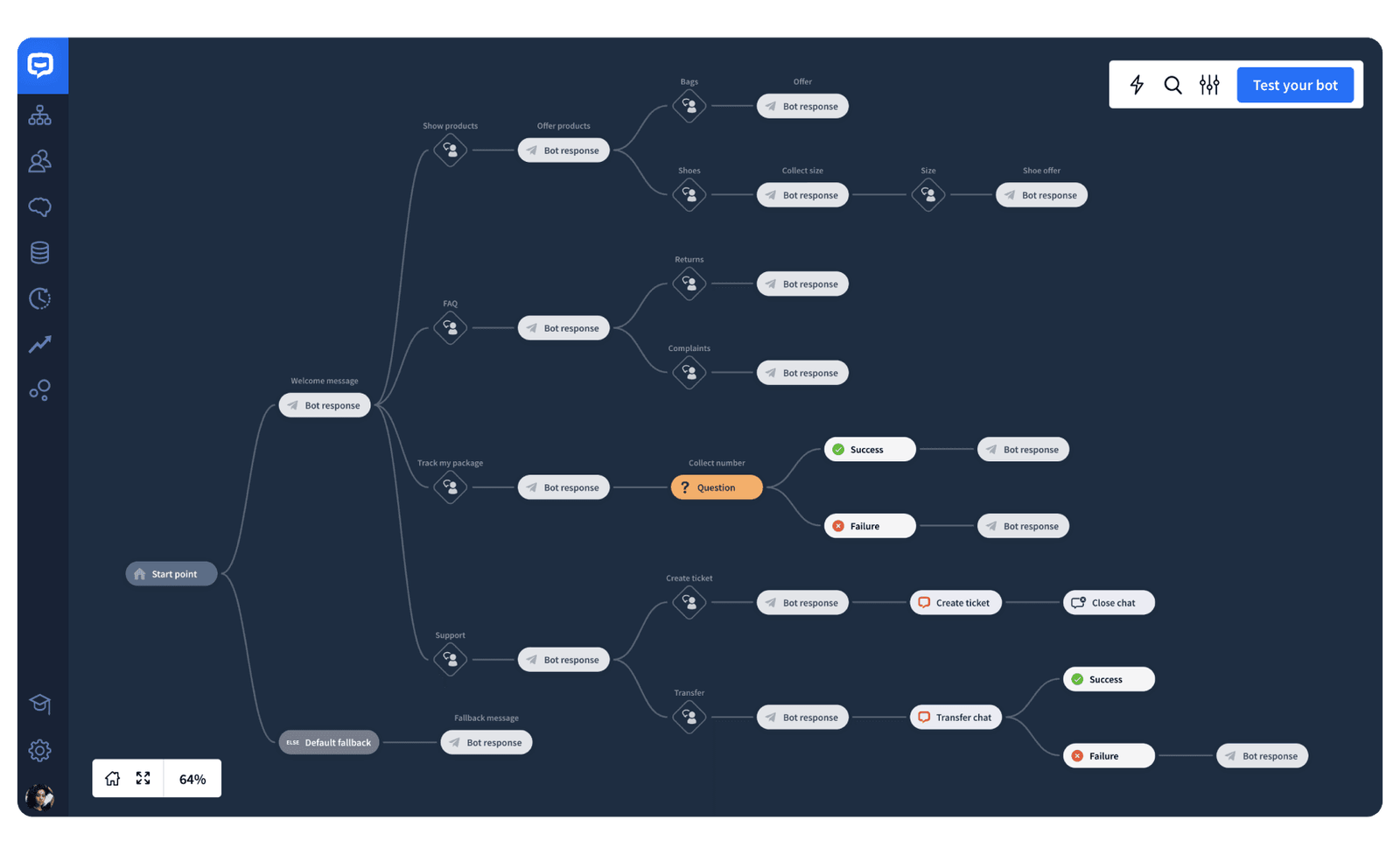

4. Set up your chatbot KPIs
Once you choose your chatbot solution, it’s time to set viable goals for your AI assistant. You can use it to improve lead generation, shorten the issue resolution time, or boost customer satisfaction rates.
Many metrics can help you measure the efficiency of your chatbot. It can be the number of open sessions, completed conversations, or the number of collected leads. The possibilities are endless. However, remember that you can’t expect your brand-new chatbot to fulfill all your goals at once. It may happen that your new bot doesn't achieve your initial goals but helps to achieve other ones. This is why it's important to track your chatbot’s performance and analyze its overall impact on your business.
5. Plan your chatbot story
Choosing the right platform is half the battle. The other half is your chatbot scenario.
Creating a gripping chatbot story is not an easy task, and it might be hard to build in the first place. So, if you’ve never written a script for a chatbot, check out some good examples first. You can chat with some existing chatbots to get inspiration and find out what characteristics make them engaging.
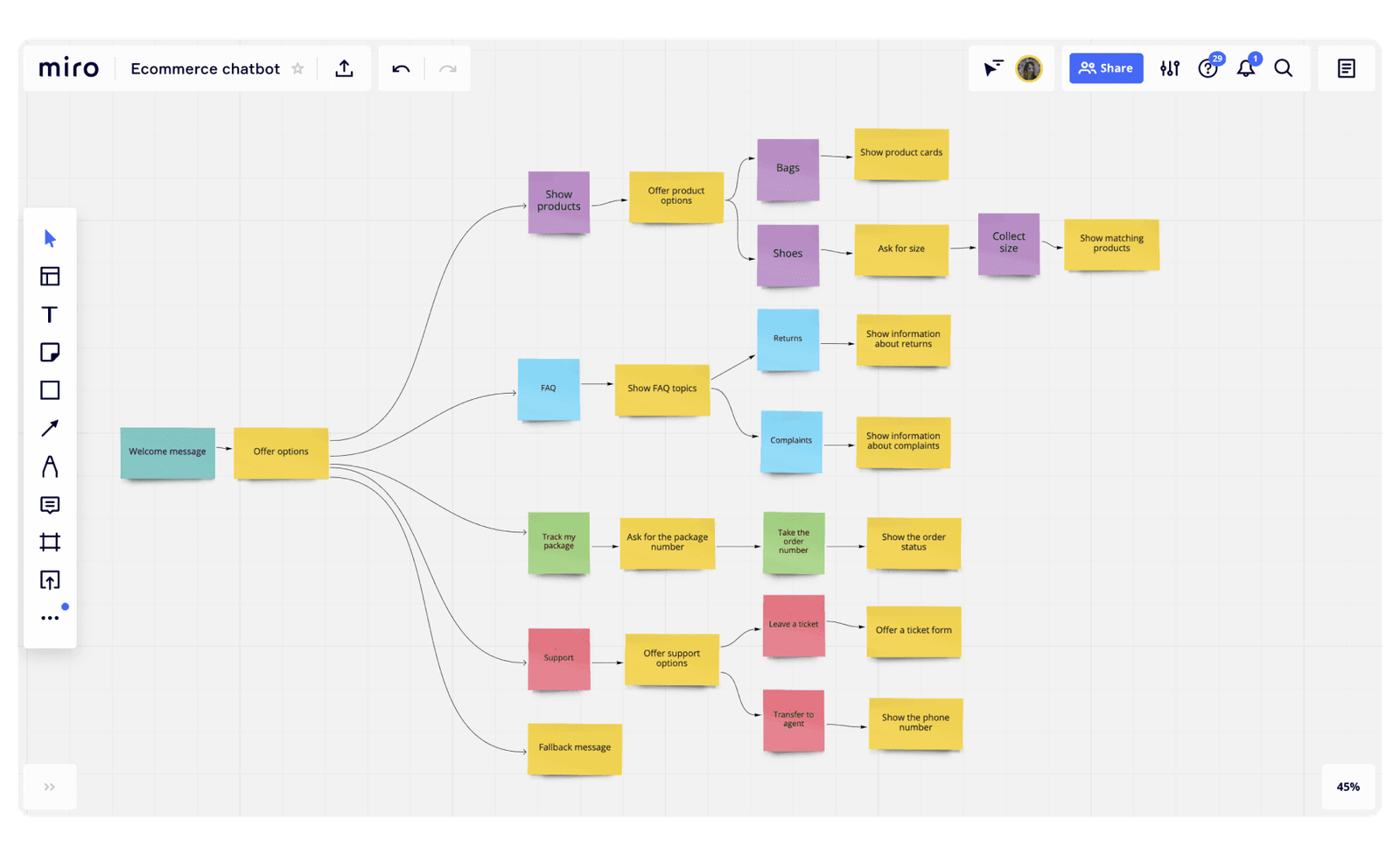

Setup Greetings
1. Set up chatbot greetings
First impressions matter. Chatbot greetings will help you get them right.
You should use a compelling welcome message to make the user’s first meeting with a chatbot memorable. Also, you can create various greetings for different pages and channels to make your chatbot experience more contextual.
Use greetings to inform customers about seasonal sales or available coupon codes. Be creative, and come up with catchy CTAs that will motivate the visitor to take action.

2. Design your chatbot’s personality
Your chatbot can be much more than an additional way for customers to contact you on your website. If you give it a unique personality that matches your brand image and website design, you’ll get a smart brand ambassador that can work for you 24/7. Here are some general rules that will help you make a winning personality for your chatbot.
Don’t give your chatbot a human face
Be transparent by telling users they are talking with a chatbot
Define your chatbot tone and voice based on your target audience
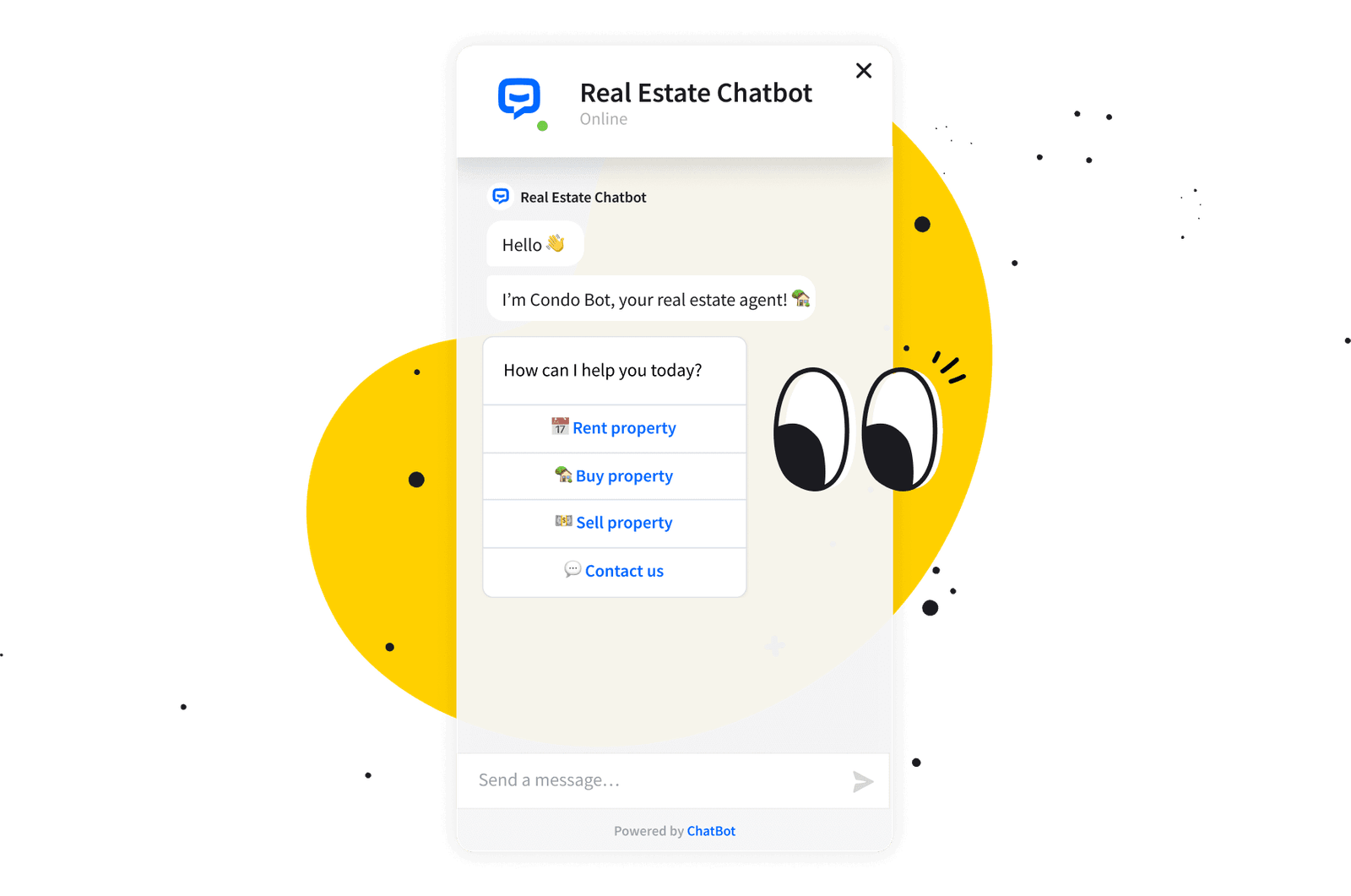

3. Show the value
It doesn't matter whether you use a chatbot to gather customer emails, deliver after-hours support, or carry out product surveys. Your chatbot should always inform users at the very beginning how it can help them.
If your message is too long for a greeting, plan it right after the welcome message. Make sure your customer knows what they can do with your chatbot. Also, avoid using too many qualifying questions. They can put your customer to sleep and discourage them from chatting. Instead, use a small amount of copy and catchy visuals that hook the customer from the get-go and convince them to stay.
4. Show off your buttons
Buttons are a great way to guide users through your chatbot story. They offer available options and let a user achieve their goals without writing a single word.
Because of that, they’re good for users who interact with chatbots using their mobile devices. When a user types their answer, they’ll make mistakes or use phrases that your chatbot is not prepared to answer. That can confuse the bot and spoil the experience for the user. Buttons let you reduce the potential for misunderstandings. They boost your chatbot’s engagement and improve conversation dynamics. Below, you’ll find some tips and tricks that can help you make your buttons successful.
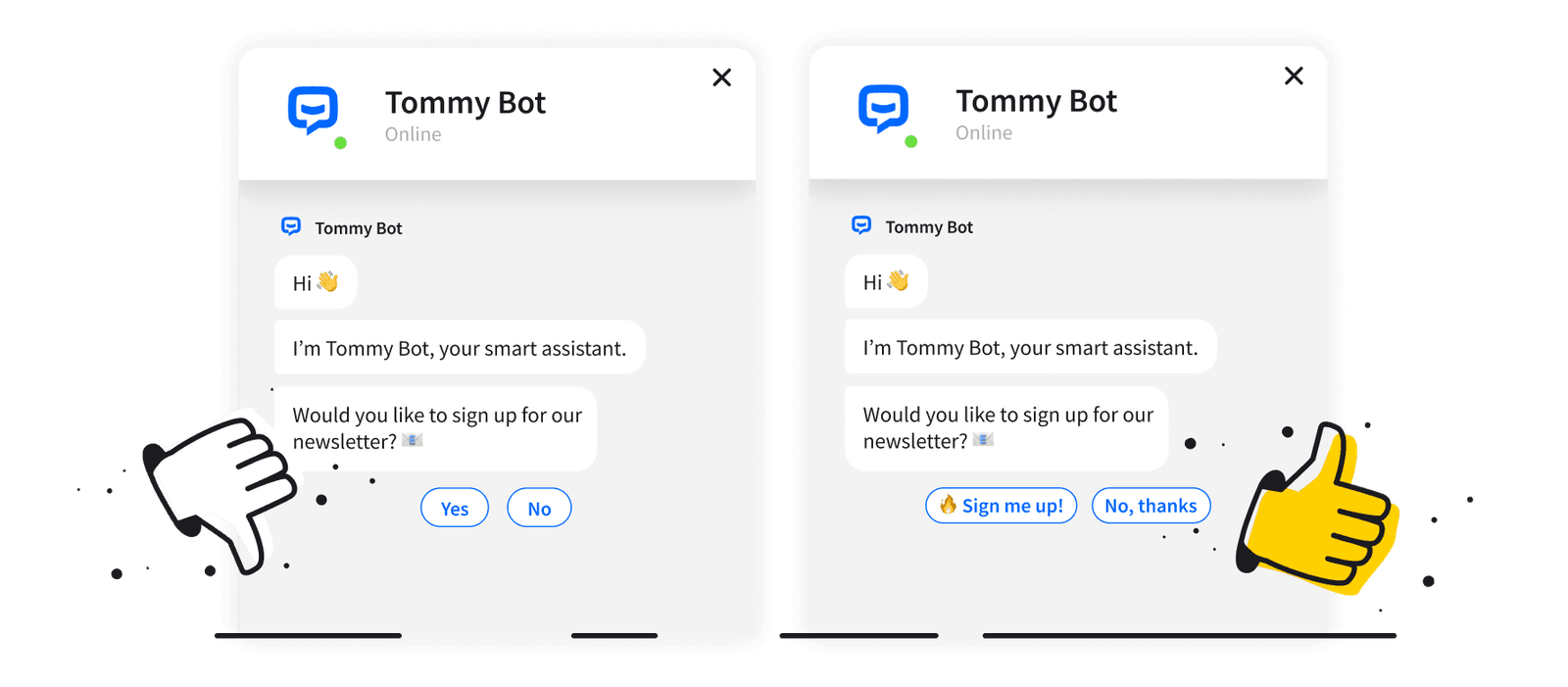

Use more contextual copy
“Yes/No” options aren’t bad, but your buttons will work better if you add some context to them. For example, when a user jumps through your story quickly, they immediately know what will happen after clicking a button.
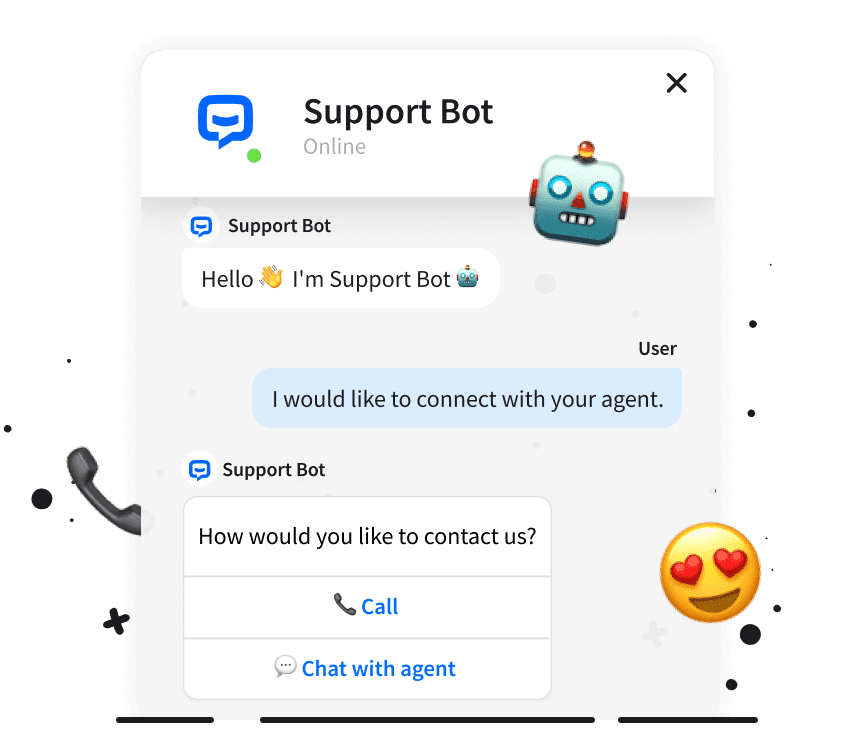
Add some smileys
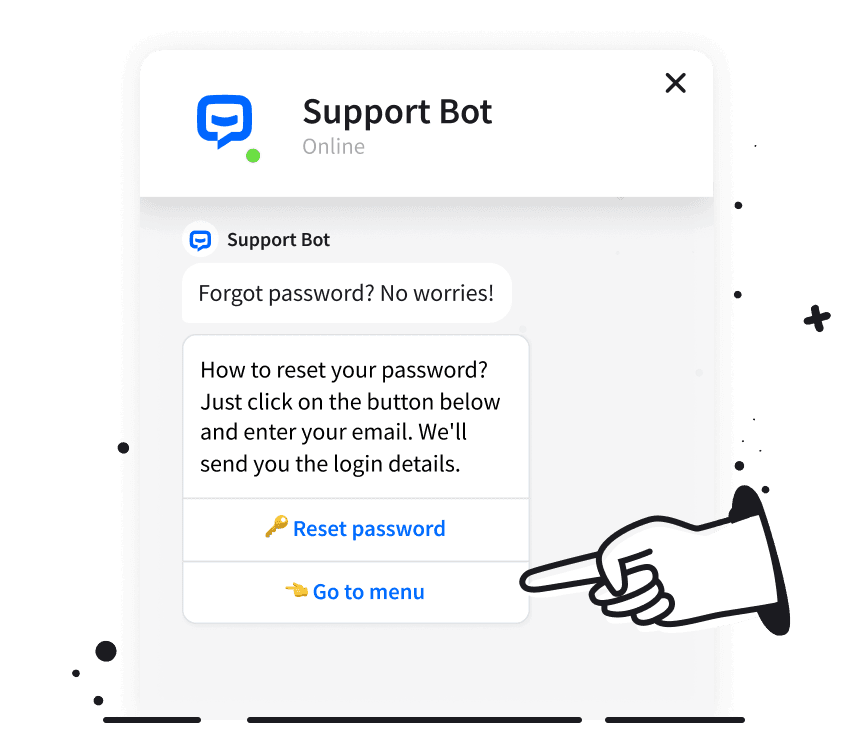
Streamline navigation
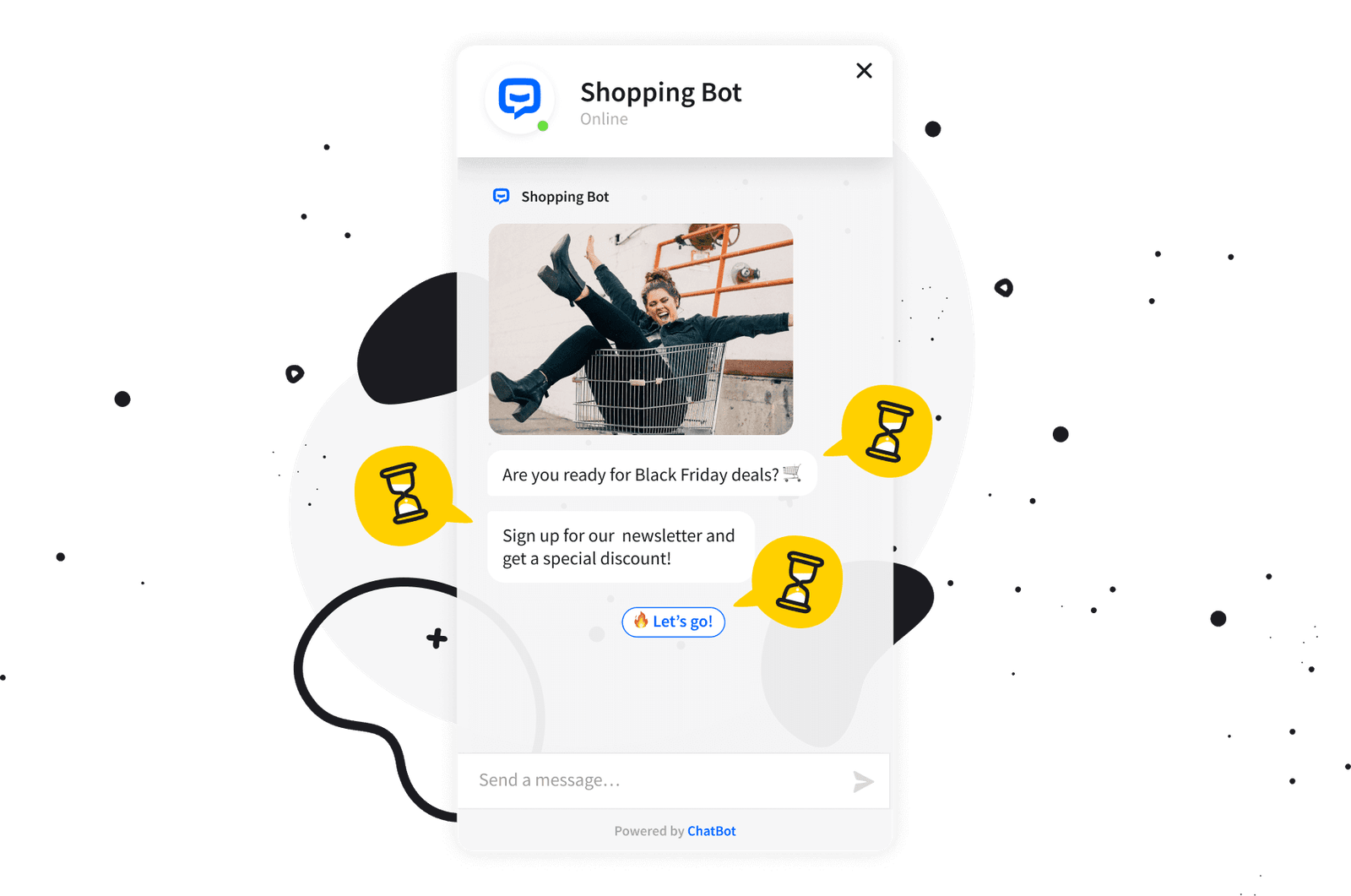

5. Let your chatbot take a breather
Chatbots can find information and deliver it to a user at the speed of light. Yet, when it comes to conversational interfaces, faster doesn’t always mean better.
When a chatbot sends a lot of messages one after another, a user can’t keep up with reading them and needs to scroll back. That destroys a user’s experience. You can avoid that by using conversation delays. Conversation delays let you decide how long the interval between chatbot messages should be. Proper delays let users absorb information at a comfortable pace and create a more natural experience.
Also, while writing your chatbot messages, remember about message chunking. It’s a method of breaking up long blocks of texts into smaller pieces. Making your messages shorter will help users to process them. Besides that, a user will be more likely to engage with your chatbot if they feel they are an active participant in the conversation and not just a reader.
6. Design the right fallback message
Making mistakes is as common for people as it is for chatbots. So, even if you create a great chatbot, it might still get baffled by the user's question.
If that happens, a chatbot can send a fallback message. It’s a type of message that is displayed when your chatbot can’t match the user’s questions with any chatbot response. A fallback message is a very important element of your chatbot scenario. It gives the bot a chance to recover the conversation when miscommunication happens. How can you make your fallback message successful?
Avoid generic answers
Create different variations
Shift the user's attention
7. Test your chatbot the right way
Even if you spend hours planning and writing the story for your chatbot, there’s always something that might not work the right way. So, here comes the testing phase. It’ll help you verify whether your chatbot works as intended and if your story does what it’s supposed to do.
The best way to poke and probe your chatbot is to give it to beta testers. Simply put, share your initial chatbot with your teammates or friends, and ask them to go through its scenario. Ask them what they feel while chatting with your chatbot and whether they find anything unclear. You’ll be surprised how much useful feedback you’ll gather and how many things went unnoticed during the building phase.
Measure and improve your performance
Your chatbot is up and running. Now, it’s time to see how it's doing and verify whether it meets your initial KPIs.
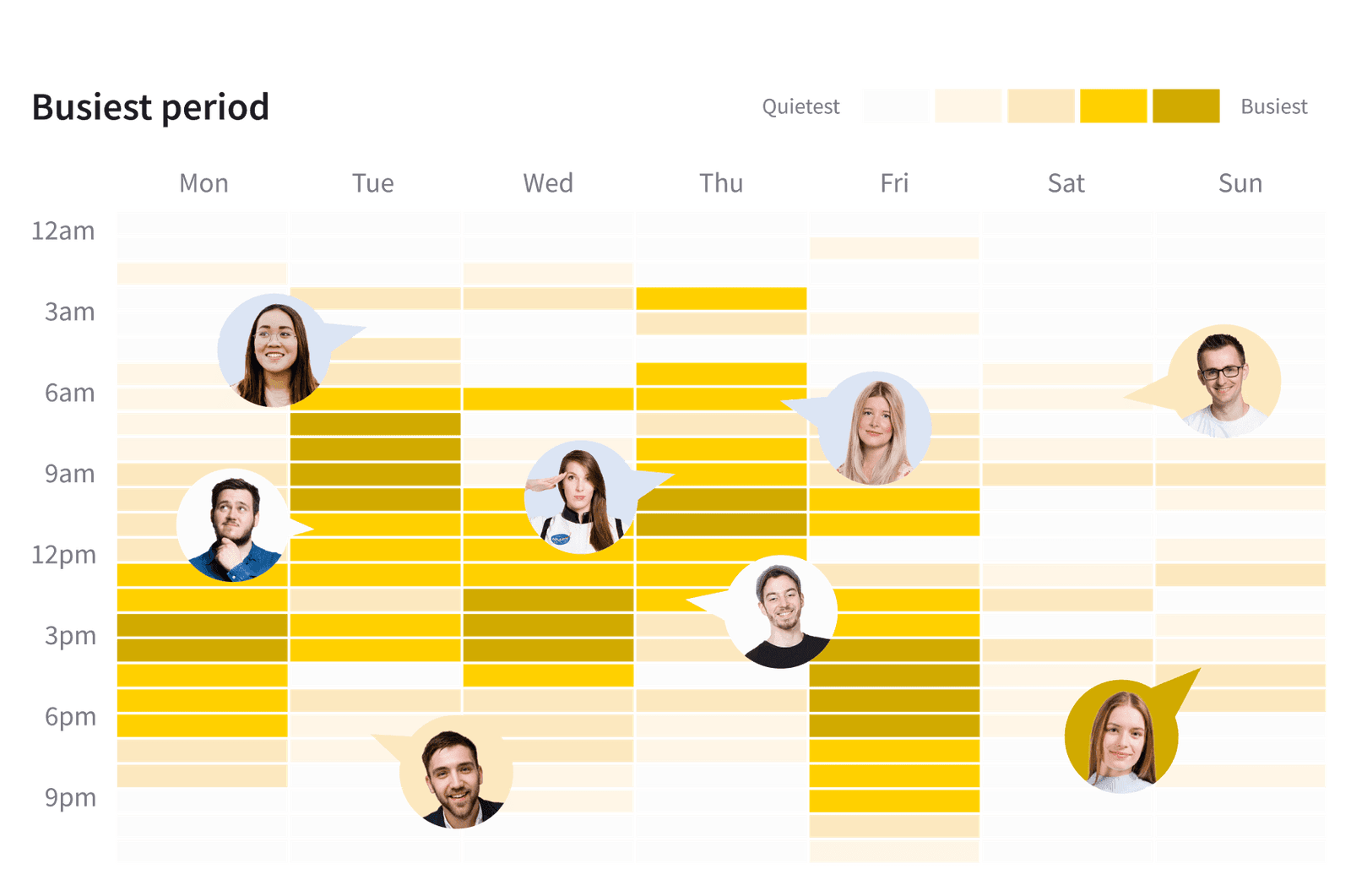

Observe trends

Respond to shifting users' needs

Get to know your users

Stay up to date
Last but not least, if you find out that your results are worse than expected, it doesn’t mean that using a chatbot was a bad idea. Your chatbot might be missing just one vital element that’s stopping it from being successful. So, no matter the results, dig deeper to find out what is influencing your chatbot’s performance.
Wrapping up
That was a long ride, but you’ve made it. Well done! Building an effective chatbot requires a lot of consideration and planning. You’ll need to spend as much time building and testing it, too. I hope, though, that our definitive list of chatbot best practices will help you create a powerful chatbot for your business. Easily automate your customer communication and reap even more benefits in the future!
